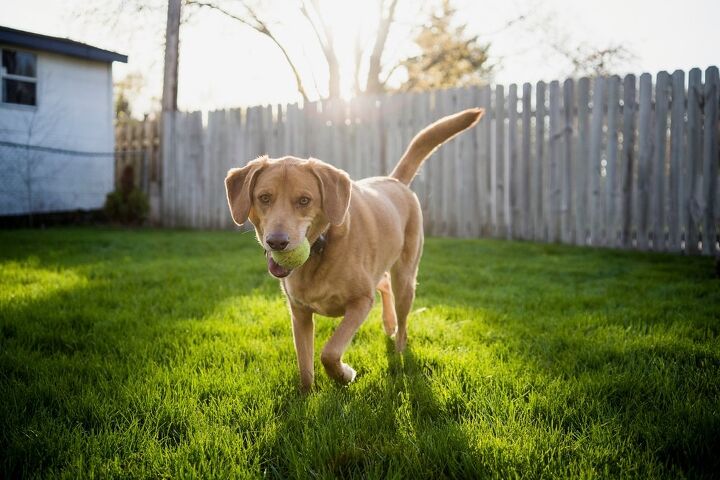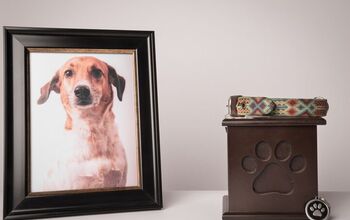Bringing Home Fido? Tips To Dog-Proof Your Backyard

Adding a dog to the family is lots of fun, and your new furry family member will bring a bunch of love and joy into your home. But pups also come with some extra responsibilities and considerations when it comes to your house, especially the backyard. So, how do you dog-proof your backyard to keep your pet safe and your yard in good shape?
The best way to dog-proof your backyard is to put up a secure fence, keep the yard tidy, and remove toxic plants. Reduce the amount of wildlife in your yard by eliminating bird feeders. Set up pet-friendly zones with shade, and create special dig areas if your pup loves to dig. Fence off pools, and lock up yard equipment and supplies.
Your new pooch might be a digger, a top-notch escape artist, or simply a curious pup that gets into everything. No matter what your dog’s personality is like, use these tips to make your backyard safe.
10 Ways To Make Your Backyard Dog-Friendly
You never want to experience that flash of despair, the knot in your stomach, when you realize your dog got out of the backyard. Or, you find your dog listless on the back porch because they got into something toxic in the garden.
Therefore, it’s essential to take precautions and stay vigilant regarding your yard. Doing so drastically reduces the likelihood that you’ll ever need to experience these awful situations.
1. Put Up A Fence
If you don’t already have a fence around your yard, it’s important to put one up when you get a dog. You want to choose a secure fence that makes sense for your neighborhood but also consider your pup. For example, if they’re a jumper, opt for a taller fence as opposed to a short, picket style.
Pay attention to the style of the fence, too. Look for one that doesn't have big gaps between slats or leave a wide space between the ground and the fence’s bottom. Depending on your dog’s size, they could squeeze between boards or wriggle underneath if they’re keen to escape. Another possibility is they could get stuck, injure themselves, or worse.
When entering and leaving your yard, close and latch the gate behind you, and ask others to do the same. Place a sign on the front of your gate alerting people to the fact that there’s a dog present.
2. Use Pet-Friendly Plants
Only use pet-friendly plants and flowers in your garden. If you have potted plants or get any from friends as gifts, ensure they aren’t toxic to dogs. The ASPCA Toxic and Non-Toxic Plant List is a good resource when you’re choosing what to put in your garden.
If you’re unsure about plants that are already present, identify them or remove them. If your pup does get a hold of something, call the Animal Poison Control number, (888) 426-4435.
Another thing to keep an eye out for is mushrooms that periodically pop up in yards, especially when lots of moisture is present. Some mushrooms are highly toxic to dogs. If your yard is prone to getting them, scan your yard every day before you let your dog out and promptly remove any mushrooms.
3. Mow The Lawn Regularly
Protect your dog from fleas and other parasites as much as possible by keeping grass trimmed. Tall grass makes a great home for fleas and ticks, which can get on your dog and infect them with diseases.
Cutting the grass can get rid of ticks and removes a favorable home for parasites. Avoid using pesticides and other chemical methods to get rid of pests, as these products can be hazardous to your pet.
4. Get A Pool Fence
Roughly 5,000 pets drown in pools each year. If you have a pool, put a pool fence up around it. Even if your dog swims and loves the water, they should never be in or around a pool unsupervised. Unfortunately, it’s all too easy for accidents to happen, and these accidents are typically preventable.
For example, a vision-impaired dog could wander into the pool. A playful pup can misjudge the distance when running and fall into the water. If a dog falls into the pool and can't find a way out, they can tire and drown.
You also want to ensure your dog doesn’t use the pool as an oversized water bowl. Consuming too much pool water can lead to throat irritation, gastrointestinal problems, or introduce parasites into the body.
5. Create Dig Zones
If your dog loves to dig, save your yard and keep your dog safe by setting up a designated doggy dig pit. This can be a roped-off section of your yard, a kiddie pool filled with sand, or an outdoor pond filled with dirt instead of water. Once you have your dig zone, take the time to train your dog to use it.
6. Add A Barrier Under Fencing
Dogs that love to reenact the dog version of Shawshank Redemption or liken themselves to a canine Houdini always seem to find a way out. A popular way is to dig a hole under the fence as an escape route. If your dog’s a digger, creating a dig pit could help.
But if your pup’s goal is to exit the yard, the dig pit won’t matter. Install a fence barrier that goes underground. Then as your dog digs, they’ll meet the barrier instead of creating a hole.
7. Lock Up Yard Equipment And Garden Supplies
Don’t leave equipment like shovels, rakes, lawnmowers, and other yard tools scattered about the yard. Your dog could poke their eye, cut themselves, or sustain other injuries. Likewise, lock up any plant food or other supplies so your pup doesn’t mistake them for a snack.
8. Don’t Use Bird Feeders
Remove bird feeders and avoid scattering birdseed in your yard. The problem is that birdseed attracts other wildlife, like mice, raccoons, etc. These animals can pose a danger to your pup.
Wild animals carry diseases and can also attack your dog. These animals also bring fleas, ticks, and parasites into the yard and leave behind parasites in their feces.
9. Ensure There’s A Shady, Dry Place For Your Dog
Always provide a shady spot in your yard for your dog so they have relief from the heat. Make sure your dog has access to fresh water and a dry place for when it rains. Even if your dog only goes outside for potty breaks and occasional play sessions, these areas are essential.
10. Keep Your Backyard Tidy
Life gets busy and often our yards reflect this with various items collecting here and there. After a busy weekend, suddenly there are kids’ toys all over the patio.
You had a cookout, and now there’s leftover charcoal scattered below the grill and tongs covered in tasty remnants lying on the outdoor bar. Or maybe you didn't have time to put away the garden shears after trimming the hedges.
When you have a furry friend running around, it’s imperative to keep the yard tidy. Dogs are curious creatures and anything that looks or smells interesting will get their attention.
Take the time to tidy up your yard and put things away. Trim hedges often so pups don’t get scratched or poked. Otherwise, go outside with your dog and supervise them until you get the chance to clean up the yard.
Create A Backyard Your Dog Can Enjoy
Make sure your backyard is a place everyone in the family can relax and enjoy, including Fido. Keep the yard tidy, mow the grass regularly, and only use non-toxic plants and flowers. Put up a secure fence and use an underground fence barrier if your pup loves to dig.
Always put up a pool fence when you have pets to prevent unfortunate accidents. Overall, these are simple, common sense tips that can make all the difference when it comes to your dog’s safety. It’s best to have all of these precautions in place before you bring your dog home for the first time.
However, if it’s not possible, make sure to always supervise your dog when they’re outside until you complete the safety tips. Regularly scan your yard for any potential danger zones and problems, and immediately correct anything that’s out of sorts .
Related Guides:

Stacy Randall is a wife, mother, and freelance writer from NOLA that has always had a love for DIY projects, home organization, and making spaces beautiful. Together with her husband, she has been spending the last several years lovingly renovating her grandparent's former home, making it their own and learning a lot about life along the way.
More by Stacy Randall














![10 Best Zero Turn Mowers – [2022 Reviews & Ultimate Buyer's Guide]](https://cdn-fastly.upgradedhome.com/media/2023/07/31/9070522/10-best-zero-turn-mowers-2022-reviews-ultimate-buyer-s-guide.jpg?size=350x220)












